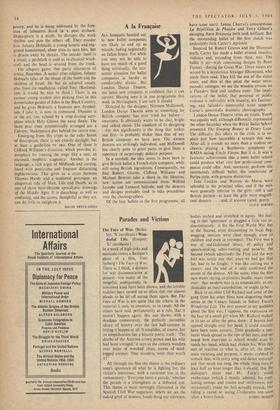A la Francaise_
Directed by the designer, Norman McDowell, London Dance Theatre aims at something no British company has ever tried for before--- smartness. It obviously wants to be chic, bright and talked about. The standard of its designing —for this significantly is the thing that strikes one first—is probably slicker than that of any British company we have seen. The sixteen dancers are strikingly individual, and McDowell has clearly gone to great pains to give them a repertory of surprisingly definite purpose.
In a nutshell, the idea seems to have been to give British ballet a French-style company, while still using British ingredients. Consequently, we find Robert Graves, Clifford Williams and Michael Bentine take a share in the librettos, new scores are commissioned from Wilfred Josephs and Leonard Salzedo, and the dancers and designs probably tend to take precedence over the choreographers.
Of the four ballets in the first programme, all
have some merit. Janine Charrat's conscientious La Repetition de Phaedre and Terry Gilbert's swinging Rave Britannia both look brilliant. But the outstanding ballet of the first clutch was undeniably Jack Carter's Agrionia.
Inspired by Robert Graves and the Dionysus myth, Carter has made a ballet around insanity, violence and, extending from these, war. The ballet is set—with convincing designs by Peter Farmer—during the Great War. Three sisters are wooed by a mysterious Stranger (Dionysus), who sends them mad. They kill the son of the eldest sister, and then at this point the scene unex- pectedly enlarges; we see the wooden crosses on a Flanders field and soldiers enter. The impli- cations of the ballet, that personal or public violence is indivisible with insanity, are fascinat- ing, and Salzedo's resourceful score supports Carter's powerfully dramatic choreography.
London Dance Theatre relies on youth. Youth was equally well, although differently, represented the other Saturday when the Royal Ballet School presented The Sleeping Beauty at Drury Lane. The difficulty this offers to the critic is to ex- plain just how incredible a venture this was. After all, it sounds no more than a student or- chestra playing a Beethoven symphony or RADA acting Uncle Vanya. But it is. It was a fantastic achievement that a mere ballet school could produce what very few professional com- panies could offer. And, moreover, perform this enormously difficult ballet, the touchstone of Petipa style, with genuine distinction.
Jane Landon and Warren de Maria were splendid in the principal roles, and if the min were generally inferior to the girls —still a sad British pattern--at least the girls were magnifi- cent dancers . . . and, if anyone cared, pretty.
CLIVE BARNES






























 Previous page
Previous page